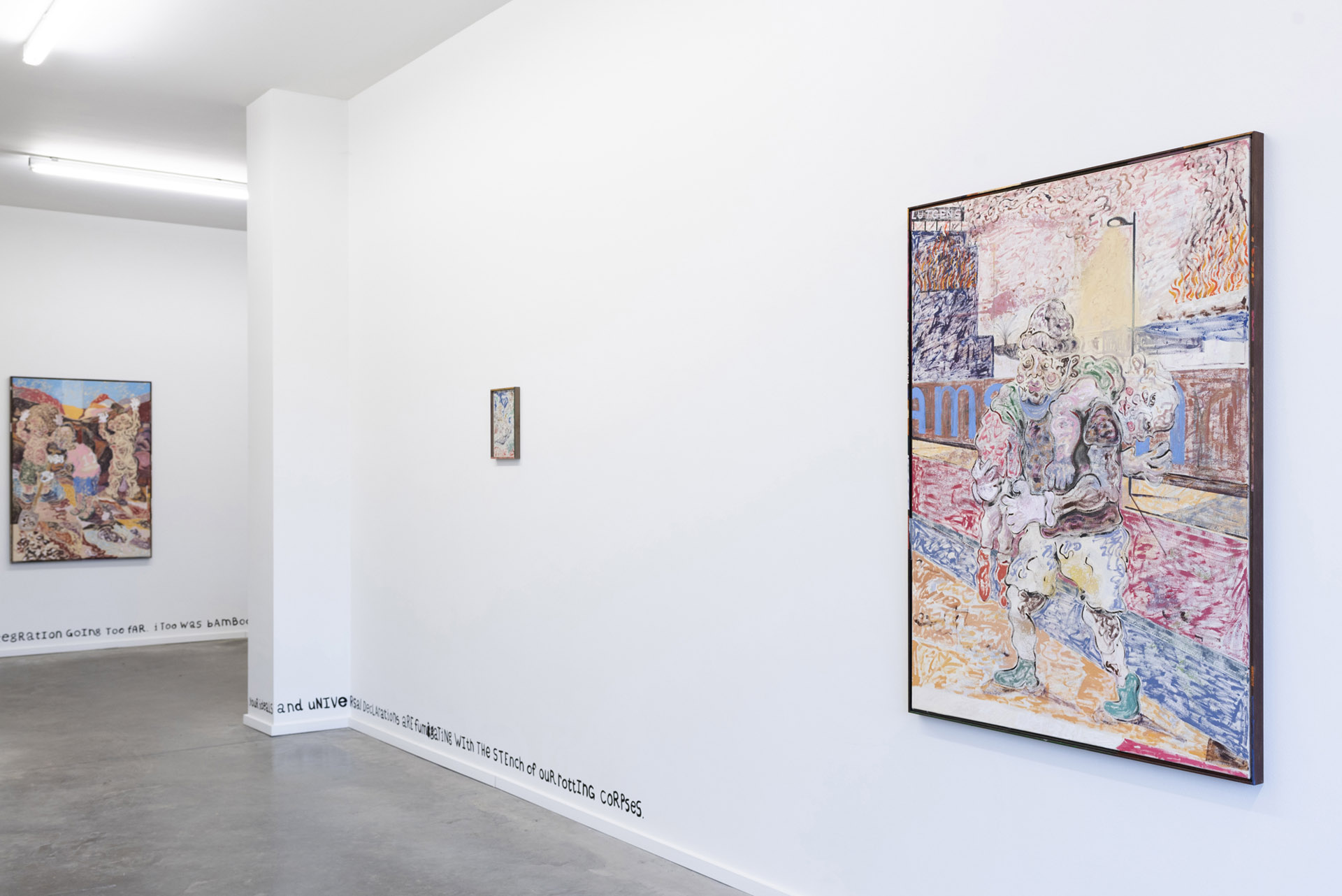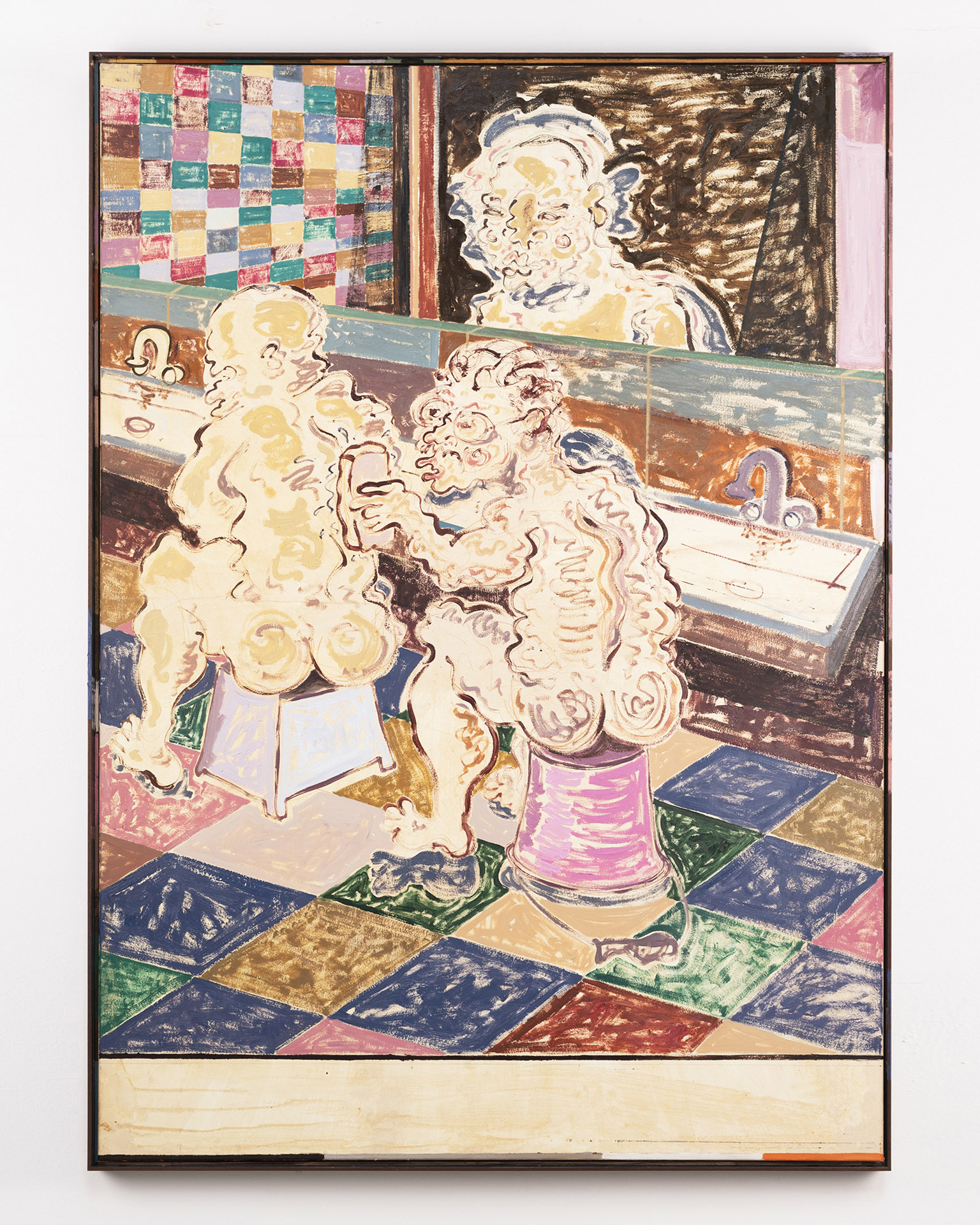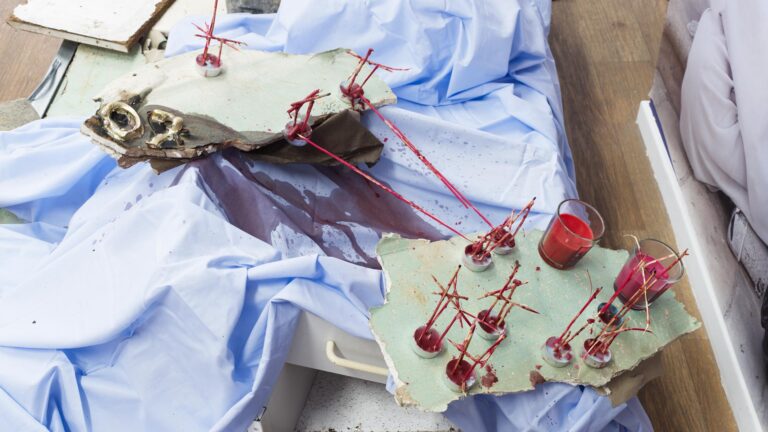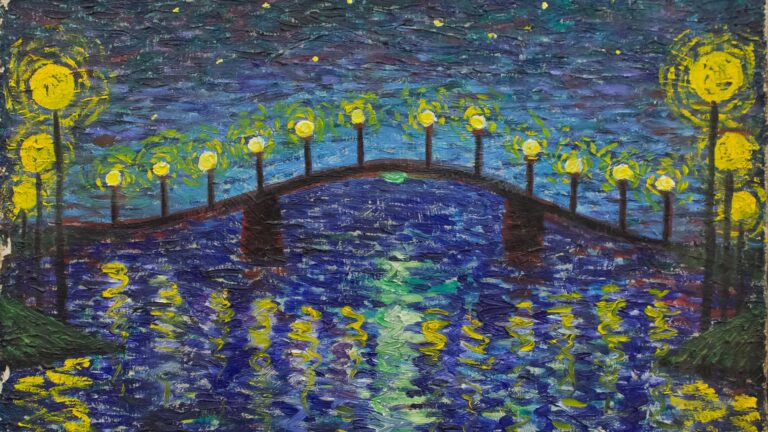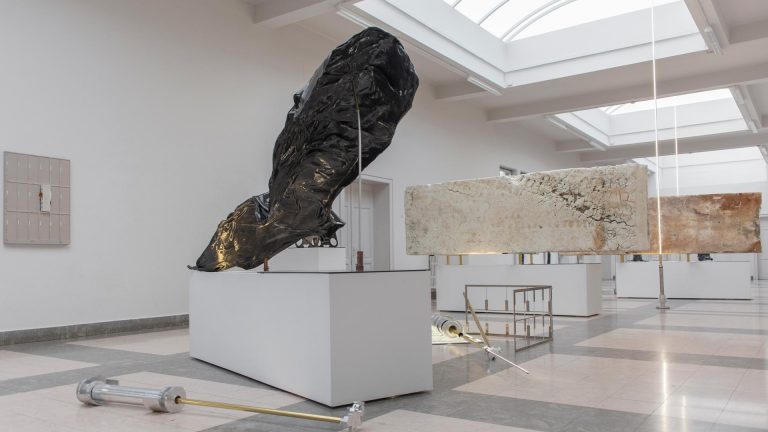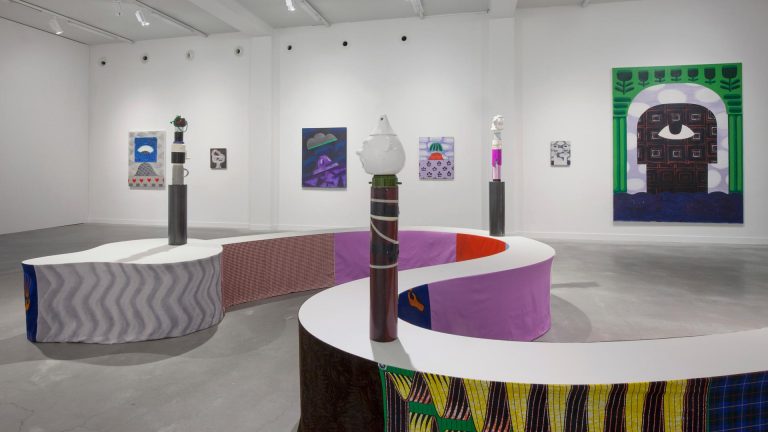Artist: William Ludwig Lutgens
Exhibition title: A Comedy of Humours
Venue: PLUS-ONE Gallery, Antwerp, Belgium
Date: December 17, 2020 – January 17, 2021
Photography: all images copyright and courtesy of the artist and PLUS-ONE Gallery, Antwerp
All the world’s a stage and according to William Ludwig Lutgens (1991) the theatre unfolding itself on it is a comedy. The scenes he brings together in this exhibition express his understanding of the human condition in all its vibrant absurdity. Seemingly banal sequences from the everyday life are enriched with references to the history of art and the debris of modern-day urban life giving the paintings an air of uni-versality while at the same planting them firmly in the contemporary. Bringing back home the experienc-es and influences he gathered during his residency in Korea and as a fellow traveler with Doctors Without Borders in the Democratic Republic of the Congo, Lutgens saw his familiar surroundings with new eyes. A discovery that resulted in his most mature works as of yet.
The Content of Matter
Considering himself a draftsman first and foremost, Lutgens had been looking for a carrier that would allow him to draw and paint at the same time and with the same swiftness. When he stumbled upon the Hanji paper that has been used for centuries in the Korean pictorial tradition, it was nothing less than an epiphany. In combination with the direct practice of applying paint unmediated to any available surface, as he had witnessed local painters doing in Congo, he developed a style that allowed him to bring his characteristic figurines, in which the hand of the artist manifests itself most strikingly, into the domain of painting. Maintaining the deliberate flatness of his drawings in the outlining of the dramatis personae of his paintings, allows him to focus more on and play more intensely with the composition of his theatrical tableaux both in terms of scenography and color. The latter consisting mostly of the earthy tones he also brought back from his trip to Congo.
Capprici alle Puttinesca
Using the humoural theory – which claims the human body and soul are regulated by four bodily flu-ids and dates all the way back to the origins of Western civilization – as the thematic focal point for the histrionic approach of his subject matter, Lutgens populates his parade of stories with the archetypal figure of the putto. These chubby, childlike incarnations of human folly contrast the gravity of the issues addressed in the scenes – some of which are taken from news footage of riots and protests, others were witnessed by the artist himself – with a joyful and almost obscene innocence. History presenting itself as farcical debauchery with an emphasis on piss and jizz, puke and blood as narrative and compositional motives. Whether they are fighting over a statue, operating or torturing a patient with sausages, engag-ing in sexual ceremonies of the sadomasochistic kind or making a victory lap on the back of a goat, they never fail to unleash and embody mayhem and mischief.
A Belgian Master (of None)
Belgium is a country born out of theater and, as such, has a predilection for it in its DNA. Lutgens is unmistakably a scion of our long tradition of artists engaging with the comical gap between our aspira-tions and reality. In the paintings brought together here we find the scabrous carnality of Breughel and a joyous unmasking of Bourgeois complacency reminiscent of James Ensor. One is also reminded of the etchings of Goya in the way our present is used to show us our failings when filtered through an ironic sensibility that is nevertheless paradoxically used to express something sincere.
As if Lutgens is not only saying “Ecce homo” but also “Isn’t he ridiculous?”
By Michaël Van Remoortere
Portrait of the Artist as a Young Fool
On William Ludwig Lutgens’ A Comedy of Humours
We live in hysterical times. Even when the world came to a screeching halt and the apocalypse did not announce itself with “lightning and thunder” or “archangel trumpets”, but through the silence of empty streets and live-streamed funerals, we were flooded with interpretations, opinions, soundbites, convoluted powerpoints and, as if things were not bad enough already, a newly invigorated moralism disguised in the pret à porter rags of Art. It was supposed to be a time of introspection but when the smog had cleared, we discovered there was no revolution in the air and yet we called our despair hope to mask our powerlessness. But amidst this turmoil of timeliness, we seemed to have forgotten this most untimely of all human endeavors; laughter.
The axiom of history repeating itself has reached the status of an obsolete and meaningless cliché. No longer an imperative of self-consciousness and knowledge, it has become an easy excuse for immobility. Nevertheless if one looks closely, the possibility of reading history anew has not vanished. Yet in order to do this one needs distance, a distance that lends itself most willingly to a specific insightfulness lying at the center of that overlooked humanistic method of research; (the) comedy. Whose definition might be the gap between ideals and reality. As such differing with tragedy only because of its inclination towards action and resilience. The distant view that allows us to broaden our scope and understanding of la comédie humaine, which only recently got called history, is what is at stake in the paintings of William Ludwig Lutgens’ A Comedy of Humours.
The beautiful surfaces of these canvasses hide a deeper, unnerving probe into the historical theories that underlie and overshadow our daily existence. The narratives that are simultaneously constructed and halted in the anecdotal scenes we are presented with, still exhibit the contemporariness of the direct observation, but have benefitted from a deep and thorough engagement with the history of art that nevertheless does not burden the image with heavy-handedness. The references are sprinkled through the series with the same generous levity and joie de vivre Lutgens conveys through his vivid approach to color and swift application of paint.
At first glance we are seduced by the misleading intuition these paintings were made quickly and seemingly off the cuff. Only on closer inspection the images reveal the density of their layers of meaning and the rigorous compositional research of which they are the result. As an artist firmly grounded in this time we share, a “time out of joint”, Lutgens knows how to move with agility (and I’m doing my best not to use the word grace) between both the remnants of history at large and the debris of present-day urban (and digital) everyday life. But it is his vision that reassembles all these signifiers into new and unexpected meaningful constellations that seduce us beyond any defense. So they can floor us unexpectedly.
Because this artist is a con man. As much as he likes us to believe him to be no more than a very skilled trickster, Lutgens has something to say, even though it might not be really clear to us what that might be. His message is never a direct one. The themes his paintings address implicitly – because his ideal audience is of the thinking kind – are not those one should be laughing at. Paradoxically however the comedy of his anecdotal approach is an invitation for us to meet the matters at hand halfway, far from any preconceived idea about, to only name a few, the post-colonial treatment of the relationship between Congo and Belgium, Black Lives Matters, the pandemic and its quarantine, the superfluous art world of the moment and all the people who profit from these movements and events.
Knowing that he cannot raise these matters without in some way incriminating himself, the artist paints a portrait of himself as young fool. Either inside the frame or as the limitations of the gaze that beholds the unfolding of the events. A caricature of the Western man, not unlike his Belgian compatriot Tintin and the fellow travelers of more “innocent” times, the big-nosed character hopping in and out of these observations never fails to be flabbergasted by the situation in which he finds himself. The story of how he went to Congo with Doctors Without Borders – by accident, because someone cancelled – could have been the beginning of a Mr. Hulot adventure were it not for the ways in which it changed our weary traveler. Something Tati never allowed his alter ego.
The fascination for this former colony of Belgium goes all the way back to the propaganda material the child who would become the painter encountered in his childhood home and testified of an exoticism he would only later came to understand when the discussion about the horrors of our national past was given its rightful place in the public discourse and imagination. A Paradise tainted by blood. With this combined mindset of the child who encounters memorabilia and a certain way of portrayal it didn’t understand and the young man afflicted by the knowledge that contaminates his childhood retroactively, the artist embarked on a journey for which he was not pr pared. Les mots sont pas les choses. Theory is easy when it does not have to adjust itself to a lived experience. What our protagonist encountered was beyond his imagination. The subjects of which all theory so easily talked, turned out to be human beings not necessarily occupied with the themes he came to expect, but with living life in its (entire) complexity. An aha-erlebnis of normalcy. Leaving all his preconceived ideas behind, the painter started looking for images that were not so easily defined or explained in hopes of undermining in his audience the exact same prejudices he had held.
Once back home Lutgens came across the humoural theory, a medicinal system rooted in the origins of Western civilization, that divides people into different categories based on the specific liquid that reigns their physical and mental constitution. From a modern day point of view said theory is as scientific as heliocentrism, but what interested Lutgens was the fact that once this had been the pinnacle of Western science and as such it became his metaphor for the hubris of western imperialism that had always claimed its legitimacy in the shadow of this most treacherous of all gods that goes by the name of science. A pretense to superiority serving as a pretext for debauchery.
And then, what he believed to have been an emblematic symbol of the past, gained relevance once more when a plague straight out of Il Decameron kept our joyous wanderer locked at home. Theories of the pseudoscientific and conspiratorial kind formed an unholy alliance that made mankind’s delusional claim to s premacy vanish like toilet paper in the supermarket. The timelines were full of gibberish but the streets, for the first time since he moved here, laid empty and so, once more, the seismographic impersonation of our times set out to discover what had been hidden in plain view all along. Even at night when he came home from the newfound strangeness of his surroundings, he learned yet another way of transcribing what had been happening all around him. The graphics and crosses which were the cu rency of the new normal found its counterpoint in the fluctuating hysteria of the stock market. This turned out to be the last sign code he needed to complete his research and finalize the iconographic building blocks of the universe he wanted to paint.
Taking the advice to heart to never waste a good crisis – and if not now, when has there ever been a good one? – our hero, as reluctant as he is enthusiastic, finally stops in his tracks to bring all these disparate influences together in the paintings collected in this exhibition. Using the formalistic conventions of an ironic heritage, he nevertheless attains the expression of something sincere. Like the philosophical idiot who did his utmost best to unlearn all the fallacies he was acquitted with since birth and now only knows he knows nothing, the artist made the world into his own theatre wherein he can stump around like a bull in a china shop with the grace of a prima ballerina. Forcing a pathway to possible exits by presenting us with the alloy of his observations, imagination and scattershot references. Not merely asking questions, which seems to be the hype in contemporary art nowadays, he is unraveling the framework wherein these questions originate. The image deconstructed by the story of its creation. Alternating between the power and impotence of the theatrical madness at the end of the world as we know it William Ludwig Lutgens presents with his Comedy of Humours the dysfunctional family of man.
-Michaël Van Remoortere
William Ludwig Lutgens, A Comedy of Humours, 2020, exhibition view, PLUS-ONE Gallery, Antwerp
William Ludwig Lutgens, A Comedy of Humours, 2020, exhibition view, PLUS-ONE Gallery, Antwerp
William Ludwig Lutgens, A Comedy of Humours, 2020, exhibition view, PLUS-ONE Gallery, Antwerp
William Ludwig Lutgens, A Comedy of Humours, 2020, exhibition view, PLUS-ONE Gallery, Antwerp
William Ludwig Lutgens, A Comedy of Humours, 2020, exhibition view, PLUS-ONE Gallery, Antwerp
William Ludwig Lutgens, A Comedy of Humours, 2020, exhibition view, PLUS-ONE Gallery, Antwerp
William Ludwig Lutgens, A Comedy of Humours, 2020, exhibition view, PLUS-ONE Gallery, Antwerp
William Ludwig Lutgens, A Comedy of Humours, 2020, exhibition view, PLUS-ONE Gallery, Antwerp
William Ludwig Lutgens, A Comedy of Humours, 2020, exhibition view, PLUS-ONE Gallery, Antwerp
William Ludwig Lutgens, A Comedy of Humours, 2020, exhibition view, PLUS-ONE Gallery, Antwerp
William Ludwig Lutgens, A Comedy of Humours, 2020, exhibition view, PLUS-ONE Gallery, Antwerp
William Ludwig Lutgens, A Comedy of Humours, 2020, exhibition view, PLUS-ONE Gallery, Antwerp
William Ludwig Lutgens, A Comedy of Humours, 2020, exhibition view, PLUS-ONE Gallery, Antwerp
William Ludwig Lutgens, A Comedy of Humours, 2020, exhibition view, PLUS-ONE Gallery, Antwerp
William Ludwig Lutgens, Dear Diarrhea, 2020, Oil pastel, coloured pencils, oil paint, spray paint and bone glue on Hanji paper, mounted on canvas, and wood., 203,6 x 142,6 cm
William Ludwig Lutgens, We love you too much to care about us, 2020, coloured pencils, graphite, oil paint, spray paint, aquarelles and bone glue on Hanji paper, mounted on canvas, and wood, 142,6 x 102,6 cm
William Ludwig Lutgens, The Village People, 2020, Coloured pencils, aquarelles, oil paint, spray paint and bone glue on Hanji paper, mounted on canvas, and wood, 142,6 x 102,6 cm
William Ludwig Lutgens, The bigger the short, the sweeter the bottom, 2020, coloured pencils, graphite, oil paint and bone glue on Hanji paper, mounted on canvas, and wood, 142,6 x 102,6 cm
William Ludwig Lutgens, The Rally, 2020, Oil pastel, graphite, oil paint, spray paint and bone glue on Hanji paper, mounted on canvas, and wood, 142 x 102 cm
William Ludwig Lutgens, A solitary man in Oran, 2020, coloured pencils, oil paint, pigments and bone glue on Hanji paper, mounted on canvas, and wood, 142,6 x 102,6 cm
William Ludwig Lutgens, Home Alone at Villa Rose, 2020, coloured pencils, graphite, oil paint, aquarelles and bone glue on Hanji paper, mounted on canvas, and wood, 142,6 x 102,6 cm
William Ludwig Lutgens, Friends of Dorothy, 2020, coloured pencils, graphite, oil paint, spray paint and bone glue on Hanji paper, mounted on canvas, and wood, 142,6 x 102,6 cm
William Ludwig Lutgens, Tick Tack, the street value of Red Herring, 2020, Coloured pencils, graphite, oil paint, spray paint and bone glue on Hanji paper, mounted on canvas, and wood, 142,6 x 102,6 cm
William Ludwig Lutgens, The Internship, 2020, Graphite, oil paint and bone glue on Hanji paper, mounted on canvas, and wood, 142,6 x 102,6 cm
William Ludwig Lutgens, And I whipped her brother and I whipped her pa, 2020, coloured pencils, oil paint, pigments and bone glue on Hanji paper, mounted on canvas, and wood, 142,6 x 102,6 cm












